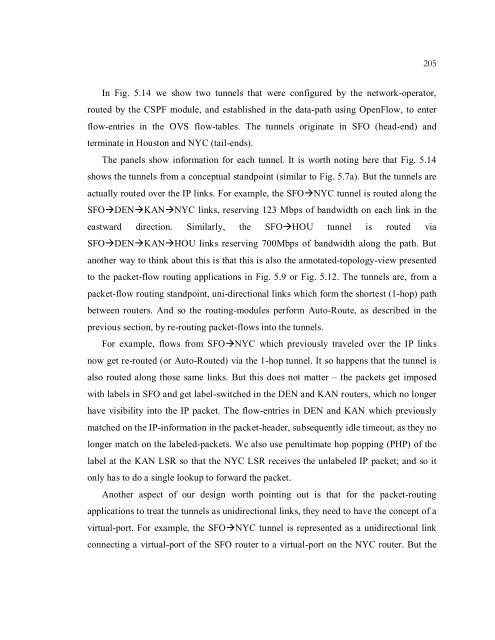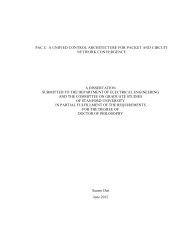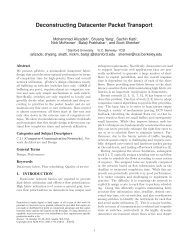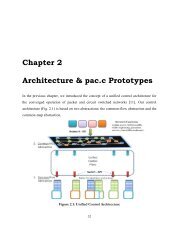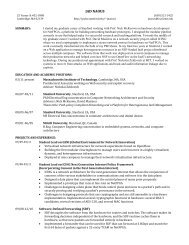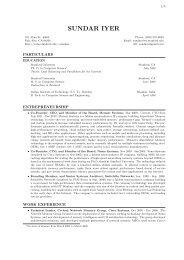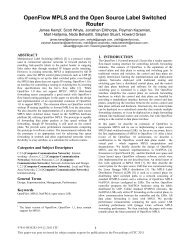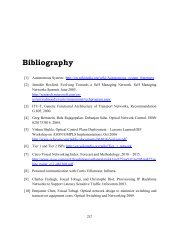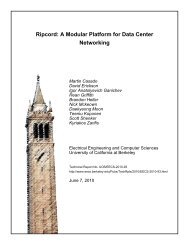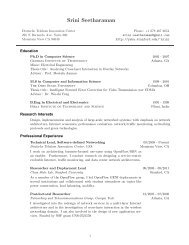Chapter 5 Introducing SDN Control in MPLS Networks - High ...
Chapter 5 Introducing SDN Control in MPLS Networks - High ...
Chapter 5 Introducing SDN Control in MPLS Networks - High ...
You also want an ePaper? Increase the reach of your titles
YUMPU automatically turns print PDFs into web optimized ePapers that Google loves.
205In Fig. 5.14 we show two tunnels that were configured by the network-operator,routed by the CSPF module, and established <strong>in</strong> the data-path us<strong>in</strong>g OpenFlow, to enterflow-entries <strong>in</strong> the OVS flow-tables. The tunnels orig<strong>in</strong>ate <strong>in</strong> SFO (head-end) andterm<strong>in</strong>ate <strong>in</strong> Houston and NYC (tail-ends).The panels show <strong>in</strong>formation for each tunnel. It is worth not<strong>in</strong>g here that Fig. 5.14shows the tunnels from a conceptual standpo<strong>in</strong>t (similar to Fig. 5.7a). But the tunnels areactually routed over the IP l<strong>in</strong>ks. For example, the SFONYC tunnel is routed along theSFODENKANNYC l<strong>in</strong>ks, reserv<strong>in</strong>g 123 Mbps of bandwidth on each l<strong>in</strong>k <strong>in</strong> theeastward direction. Similarly, the SFOHOU tunnel is routed viaSFODENKANHOU l<strong>in</strong>ks reserv<strong>in</strong>g 700Mbps of bandwidth along the path. Butanother way to th<strong>in</strong>k about this is that this is also the annotated-topology-view presentedto the packet-flow rout<strong>in</strong>g applications <strong>in</strong> Fig. 5.9 or Fig. 5.12. The tunnels are, from apacket-flow rout<strong>in</strong>g standpo<strong>in</strong>t, uni-directional l<strong>in</strong>ks which form the shortest (1-hop) pathbetween routers. And so the rout<strong>in</strong>g-modules perform Auto-Route, as described <strong>in</strong> theprevious section, by re-rout<strong>in</strong>g packet-flows <strong>in</strong>to the tunnels.For example, flows from SFONYC which previously traveled over the IP l<strong>in</strong>ksnow get re-routed (or Auto-Routed) via the 1-hop tunnel. It so happens that the tunnel isalso routed along those same l<strong>in</strong>ks. But this does not matter – the packets get imposedwith labels <strong>in</strong> SFO and get label-switched <strong>in</strong> the DEN and KAN routers, which no longerhave visibility <strong>in</strong>to the IP packet. The flow-entries <strong>in</strong> DEN and KAN which previouslymatched on the IP-<strong>in</strong>formation <strong>in</strong> the packet-header, subsequently idle timeout, as they nolonger match on the labeled-packets. We also use penultimate hop popp<strong>in</strong>g (PHP) of thelabel at the KAN LSR so that the NYC LSR receives the unlabeled IP packet; and so itonly has to do a s<strong>in</strong>gle lookup to forward the packet.Another aspect of our design worth po<strong>in</strong>t<strong>in</strong>g out is that for the packet-rout<strong>in</strong>gapplications to treat the tunnels as unidirectional l<strong>in</strong>ks, they need to have the concept of avirtual-port. For example, the SFONYC tunnel is represented as a unidirectional l<strong>in</strong>kconnect<strong>in</strong>g a virtual-port of the SFO router to a virtual-port on the NYC router. But the


